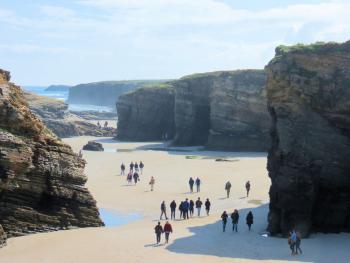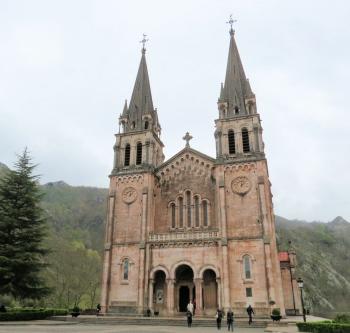Spain by luxury train --– what a wonderful way to travel!
This article appears on page 32 of the December 2016 issue.
Recently, my wife, Lorna, and I took a trip on one of the world’s most luxurious trains, Spain’s Transcantábrico Gran Lujo. An elegant luxury hotel on rails, its turn-of-the-century carriages have been remodeled to create two deluxe, wood-paneled suites per coach. Each air-conditioned suite has a king-sized bed (or two twins) plus a sitting area, a desk, Wi-Fi, a mini-bar, luxury linens, a flat-screen TV and an en suite bathroom complete with sauna, steam and hydro-massage shower.
The train also has a lounge car with picture windows, a bar and dining cars. Outstanding Art Deco design is combined with stained-glass windows and modern comforts.
Included in the fare, gourmet meals and fine wines were served on board and at restaurants along the way, and there were interesting luxury-coach excursions every day. The train traveled only four hours a day, stopping each night to ensure a peaceful sleep for its passengers.
The multilingual staff was impeccably trained and unusually attentive.
It was a decadent experience and the epitome of luxury train travel.
The passengers
The train carried only 24 passengers, and the people on our trip were from the UK, the US, Puerto Rico, Colombia, Spain, Australia, Belgium and Germany. Our fellow passengers were well traveled and included developers, lawyers, a professional photographer, writers, hoteliers, engineers, doctors, a psychologist, a financier and an industrialist.
The group quickly coalesced and became friendly. We were accompanied by excellent guides who were fluent in Dutch, Spanish, English, French and German. This was a great feature, although it often meant you stood around for some time until they got to your language — a trial during inclement weather.
Our 8-day/7-night spring 2016 itinerary took us from Santiago de Compostela to San Sebastián, passing through Galicia, Asturias, Cantabria and the Basque country. We visited enchanting medieval towns and significant cultural and historical sites and passed through some of the most picturesque landscapes in Europe.
Spectacular sights
It would be difficult to describe all that we saw, but there were several standouts.
The first was the Parador de Santiago. Built in 1499 to provide shelter and a place to rest for the pilgrims walking the Way of Saint James, this is one of the world’s oldest hotels. It is filled with history and modern comforts. Seventy-nine plaques explain the history of the parador, from its founding as a royal hospital to modern times.
This is where our group met before visiting Santiago’s cathedral, which dates to 1075. We were fortunate to be there on one of the few days in the year when the famous silver Botafumeiro was being used. One of the world’s largest incense censers, it weighs 53 kilograms (nearly 117 pounds) and requires eight priests to raise it and set it swinging on its 65-meter-long trajectory.
The next stop on our itinerary was the Playa de las Catedrales (Beach of the Cathedrals), the most unusual and spectacular beach we have ever seen. It was completely covered at high tide, but low tide revealed an amazing expanse of 30-meter-high natural arches and flying buttresses, carved by the wind and waves, covered with hundreds of thousands of barnacles. We spent an hour walking along the fine-sand beach, peering into caves, admiring the waterfalls and marveling at the huge rock formations.
Amazing architecture
We also visited Picos de Europa National Park and stopped at the Monastery of Santo Toribio de Liébana and the Sanctuary of Covadonga.
It is said that the beginnings of the reconquest of Spain began there in the eighth century, aided by a statue of the Virgin Mary that had been secreted in a cave. At the monastery, one of the largest portions of the True Cross is said to be on display, watched over by the four remaining monks.
Later, we were glad to immerse ourselves in hot water at La Balneario La Hermida, a spa that dates to the 17th century. Warmed and relaxed, we enjoyed a long lunch before getting back on the coach headed to Comillas, where we had a guided tour of El Capricho de Gaudí, a charming (if flamboyant) palace decorated with sunflower tiles designed by a young Antoni Gaudí in 1885.
It was surprisingly intact, with a differently patterned coffered ceiling in each room, original stained glass and shutters that rolled sideways and disappeared. It has been a residence, abandoned, restored and made into a restaurant and is now a museum.
Another highlight was the world-famous Cave of Altamira near Santillana del Mar. A UNESCO World Heritage Site, it is one of the first caves in which prehistoric paintings were discovered. Entry to the original cave is now restricted in order to protect the paintings, but an amazing and extremely well done replica museum has been built nearby.
We spent several hours there with a local guide, who carefully explained the discovery and history of the cave and of the people who lived there and how they created the paintings. It was beautifully reconstructed and quite breathtaking.
Near the end of our trip, we visited the city of Bilbao and the amazing and wonderful Guggenheim Museum. Designed by Canadian-born American architect Frank Gehry, it houses an eclectic collection of modern art in a spectacular titanium-clad building. We had longed to visit it for years and were not disappointed.
The building, itself, is the most beautiful avant-garde masterpiece of the 20th century, and its contents kept us mesmerized for hours. A huge, 12-meter-high flower-covered sculpture of a West Highland terrier created by Jeff Koons welcomes visitors and has become the emblem of the museum and the city, itself.
The journey ended in San Sebastián after the train staff gathered ’round with kisses and hugs for everyone. The passengers did the same, accompanied by an exchange of email addresses and invitations to visit.
What to keep in mind
There are a few things to keep in mind if you want to take this train tour.
The first is weather. Remember that this is the northern, very green part of Spain, and it is cooler and wet there. We went at the end of April and had warm, sunny days and a few that were rainy and downright cold. The train had umbrellas for everyone, but travelers each should be sure to take a warm jacket and layers that will keep them toasty.
Avoid going late in the summer, when you could run into crowds.
When arranging our trip, we found that trying to book through Renfe, the Spanish train company, was very difficult and frustrating in any language. We resorted to booking through Palace Tours in New Jersey (800/724-5120, palacetours.com), who were cooperative and helpful. (We never did find a Canadian firm.)
We were certainly fed well on our trip, but meals were on Spanish time, which meant they were late and long. Breakfast was at 8, and we were expected to be on the excursion bus by 9:30. Lunch was at 2, and dinner started at 9.
The food was generally good, but the menus were set and we were never offered any choices. We felt that some of the restaurant meals were not as wonderful as we had expected, and anyone with an allergy or dietary restriction might find it difficult to be accommodated. However, most people did put on a few pounds.
We often had free time in the villages visited on our excursions, but this rarely exceeded an hour, which didn’t make for great shopping opportunities, especially if it happened during the Spanish siesta, when the shops were closed.
This was a very busy tour, with many things organized every day. We all fell into our beds for a good sleep at the end of each day, and those who chose to party into the early hours were often seen snoozing on the bus.
Thankfully, there were no formal nights on the train, and passengers were comfortable in casual clothes. People did dress up for our final evening, and some men, but not all, put on jackets.
This was not an inexpensive trip; suites started at $4,000 per person. But everything was included: food, drink, excursions, entrance fees, etc. Tipping was optional, although it seemed that everyone contributed.
It was a wonderful, elegant tour on a very special train.




